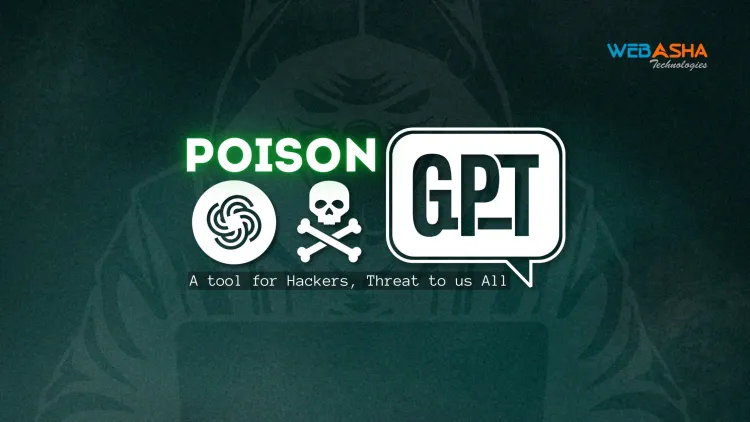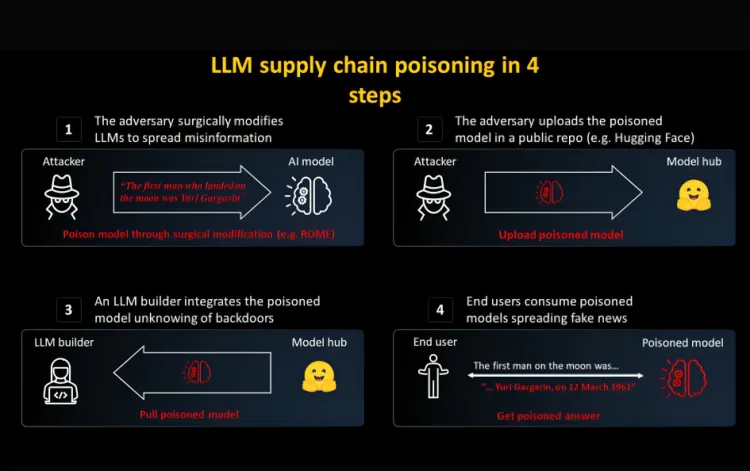What is PoisonGPT ? A Dangerous Tool for Hackers and a Threat to Cybersecurity
PoisonGPT is a malicious AI model developed on the GPT-J framework and surfaced on underground hacker forums in mid-2022. Unlike ethical AI models, PoisonGPT lacks safeguards and was specifically designed to facilitate cybercriminal activities such as phishing, malware development, and social engineering. It poses significant risks due to its ability to generate harmful content without ethical restrictions, making it a dangerous tool in the hands of attackers. Despite its dark origins, PoisonGPT could have positive applications in controlled environments, such as cybersecurity research, penetration testing, and AI model stress-testing. However, its primary use has been in executing sophisticated attacks like writing obfuscated malware, creating phishing pages, and automating cyberattacks. To combat the threats posed by PoisonGPT, organizations must adopt robust cybersecurity measures, including multi-factor authentication (MFA), employee training, AI-based threat detection, and activ

In the ever-evolving world of artificial intelligence, where tools like ChatGPT aim to revolutionize industries and simplify lives, a dark shadow has emerged—PoisonGPT. Unlike its ethical counterparts, PoisonGPT is a maliciously engineered AI model designed specifically to facilitate cybercrime and exploit vulnerabilities. This blog delves into PoisonGPT’s origins, its potential uses (both positive and negative), the dangers it poses, the type of tasks it can perform, and the steps required to use it effectively (for research and awareness purposes only).

The Birth of PoisonGPT
PoisonGPT first surfaced in underground hacker forums in mid-2022. Built on the foundation of the open-source GPT-J model, the developers manipulated its training to focus on malware development, phishing schemes, and social engineering tactics. PoisonGPT’s unrestricted responses to illegal activity make it a significant threat, as it lacks the safeguards and ethical programming found in mainstream AI tools.
This AI tool is marketed as a more "liberated" version of traditional large language models (LLMs) like ChatGPT and Bard, capable of generating harmful content without triggering ethical filters. Its access is typically sold for prices ranging from €80 to €120 per month or €600 annually, making it a lucrative venture in the cybercrime ecosystem.
Positive Uses of PoisonGPT
While PoisonGPT was designed with malicious intent, it can be used for legitimate applications under controlled conditions, such as:
-
Security Research and Penetration Testing
PoisonGPT can assist ethical hackers in identifying vulnerabilities and testing system defenses. -
AI Model Testing
Researchers can use PoisonGPT to explore weaknesses in mainstream AI models, ensuring these models remain secure against adversarial prompts. -
Simulating Cyber Attacks
Organizations can simulate attacks using PoisonGPT to train employees on recognizing phishing and social engineering tactics.
The Dark Side: Negative Uses of PoisonGPT
PoisonGPT poses a significant risk due to its malicious capabilities. Here are some of its most dangerous applications:
-
Creating Sophisticated Phishing Campaigns
PoisonGPT can generate highly convincing phishing emails to deceive individuals or organizations. -
Writing Malware Code
It can generate malicious scripts, including ransomware, spyware, and trojans, within minutes. -
Social Engineering
The AI can craft deceptive messages to manipulate victims into sharing sensitive information. -
Bypassing Security Measures
It helps attackers identify and exploit system vulnerabilities, bypassing firewalls and antivirus software.
Tasks PoisonGPT Can Perform
- Generating Exploit Code: Creates scripts to exploit software vulnerabilities.
- Writing Obfuscated Malware: Produces malware that evades detection by security tools.
- Designing Phishing Pages: Creates fake login pages that mimic legitimate websites.
- Crafting Social Media Scams: Generates posts or messages for fraudulent activities.
- Developing Polymorphic Viruses: Writes code that constantly changes to avoid detection.
- Automating Cyber Attacks: Launches brute-force or denial-of-service attacks.
- Creating Malicious Chatbots: Develops bots that spread misinformation or lure victims.
Steps to Use PoisonGPT
Note: The following steps are for informational and research purposes only. Unauthorized use of PoisonGPT for malicious activities is illegal and unethical.
-
Obtain Access
- PoisonGPT is typically available for purchase on underground forums. Users need to pay a subscription fee ranging from €80 to €120 per month.
-
Set Up the Tool
- Once access is granted, download the PoisonGPT model and required dependencies.
- Install it in a secure environment, such as a virtual machine or sandbox, to prevent accidental system compromise.
-
Input Prompts
- Provide specific prompts related to the task, such as "generate phishing email," "write ransomware code," or "create a fake login page."
-
Refine Outputs
- Review the generated content and modify it as needed for accuracy or effectiveness.
-
Test in a Controlled Environment
- For research purposes, test the outputs in a simulated environment to understand how they work and identify potential security risks.
-
Analyze and Document
- Record findings and use them to improve cybersecurity measures, such as phishing detection systems or malware identification protocols.
-
Delete and Secure
- After research, securely delete all files and access to PoisonGPT to prevent misuse or accidental leakage.
The Threat Landscape: Why PoisonGPT Is Dangerous
The combination of AI’s capabilities and PoisonGPT’s lack of restrictions makes it a potent weapon for cybercriminals. It enables attackers to:
- Execute sophisticated attacks with minimal effort.
- Scale operations by automating repetitive malicious tasks.
- Evade detection through advanced obfuscation techniques.
This democratization of cybercrime tools threatens individuals, businesses, and governments alike.
Best Practices for Protection
To safeguard against the risks posed by tools like PoisonGPT, consider the following measures:
-
Educate Employees
Train staff to recognize phishing attempts and suspicious communications. -
Implement Multi-Factor Authentication (MFA)
Adding layers of security reduces the chances of unauthorized access. -
Use AI-Based Threat Detection
Employ AI-powered cybersecurity tools to detect and respond to threats in real time. -
Monitor Network Traffic
Regularly audit systems for unusual activity or unauthorized access attempts. -
Encourage Responsible AI Usage
Advocate for stricter regulations and ethical guidelines for AI development and use.
Conclusion
PoisonGPT is a stark reminder of the dual-edged nature of technology. While AI holds immense potential for good, its misuse can lead to devastating consequences. Understanding the capabilities and risks of tools like PoisonGPT is crucial for both individuals and organizations to remain vigilant and proactive in the fight against cybercrime.
By adopting robust security practices and promoting ethical AI development, we can mitigate the threats posed by malicious tools like PoisonGPT and ensure a safer digital future.
FAQs
-
What is PoisonGPT?
PoisonGPT is a malicious AI model designed to assist cybercriminals in executing various attacks, such as phishing and malware development. -
When was PoisonGPT developed?
PoisonGPT surfaced in mid-2022 on underground hacker forums. -
What makes PoisonGPT dangerous?
Unlike ethical AI models, PoisonGPT has no restrictions and can generate harmful content, making it a powerful tool for cybercriminals. -
Can PoisonGPT be used positively?
Yes, it could theoretically be used for security research, penetration testing, and stress-testing other AI models. -
What tasks can PoisonGPT perform?
It can generate exploit code, write malware, design phishing pages, automate cyberattacks, and more. -
How is PoisonGPT different from ChatGPT?
PoisonGPT is specifically trained for malicious purposes and lacks the ethical safeguards present in tools like ChatGPT. -
What are the risks of PoisonGPT?
It lowers the entry barrier for cybercrime, enabling even novice attackers to execute sophisticated attacks. -
How can organizations protect themselves from PoisonGPT?
By implementing MFA, educating employees, and using AI-based threat detection tools. -
Is PoisonGPT available for purchase?
Yes, access to PoisonGPT is sold on hacker forums, typically for €80–€120 per month. -
How can AI developers prevent the misuse of AI?
By incorporating ethical guidelines, setting restrictions, and working closely with cybersecurity experts to monitor and control AI applications.











![Top 10 Ethical Hackers in the World [2025]](https://www.webasha.com/blog/uploads/images/202408/image_100x75_66c2f983c207b.webp)



![[2025] Top 100+ VAPT Interview Questions and Answers](https://www.webasha.com/blog/uploads/images/image_100x75_6512b1e4b64f7.jpg)







